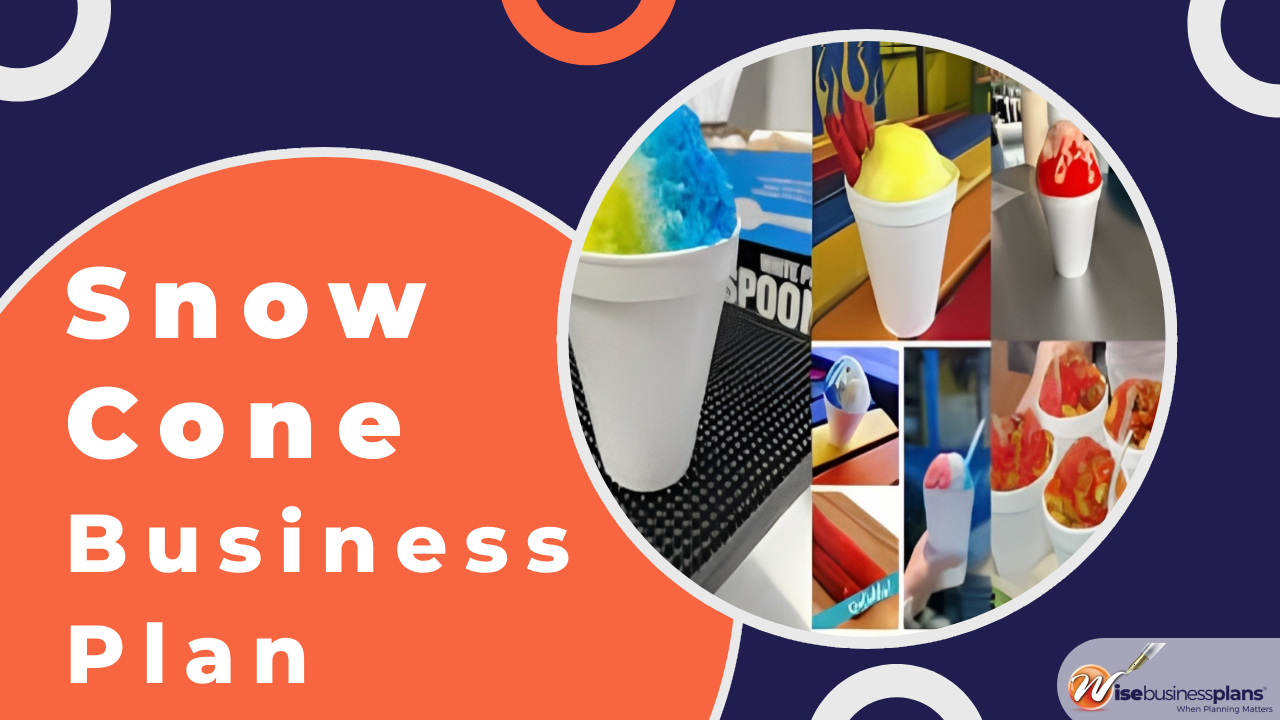Snow Cone Business Plan
Table of Contents
- Executive Summary
- Example
- Business Overview
- Example
- Market Analysis
- Example
- Target Audience
- Example
- Product and Menu Selection
- Example
- Pricing Strategy
- Location and Equipment
- Marketing and Promotion
- Example
- Operations and Management
- Financial Projections
- Example
- Risk Assessment
- Example
- Conclusion
- Looking for a business plan writer?
- FAQs
Hire professionals who can help write a business plan.
Starting a snow cone business can be a profitable venture, especially during the hot summer months when people are seeking refreshing treats. To ensure the success of your snow cone business, it is essential to have a well-defined business plan in place. This article will guide you through the process of creating a comprehensive snow cone business plan, highlighting key aspects and providing real-life examples for better understanding.
Executive Summary
The executive summary provides an overview of your snow cone business plan, summarizing key points and objectives. It should briefly outline your vision, mission, target market, and financial projections. The executive summary serves as a snapshot of your entire plan and should capture the reader’s attention.
Example
In the case of “Cool Cones,” the executive summary would highlight their goal of becoming the leading provider of unique snow cone flavors in the Miami area, targeting families, young adults, and tourists. They anticipate a 20% increase in revenue over the next three years.
Business Overview
In this section, introduce your snow cone business and provide details about its legal structure, ownership, and location. Describe your business concept, including the types of snow cones you plan to offer, any unique selling points, and the overall experience you aim to create for your customers.
Example
“Cool Cones” is a family-owned business that operates from a vibrant beachfront kiosk, attracting customers with its tropical-themed decor and friendly staff. They specialize in offering organic, all-natural snow cone flavors sourced from local fruits.
Market Analysis
Conduct a thorough market analysis to identify your target market, understand their preferences, and assess the competitive landscape. Determine the demand for snow cones in your area, analyze consumer trends, and research competitors to gain insights into their strengths and weaknesses. This information will help you tailor your business strategies accordingly.
Example
In the Miami market, “Cool Cones” conducted market research and discovered a high demand for unique, tropical flavors among both locals and tourists. They also identified a lack of direct competitors in the immediate vicinity, giving them a competitive advantage.
Target Audience
Identify your target audience based on demographics, psychographics, and behavior patterns. Determine who your ideal customers are, including families, teenagers, or professionals. Understanding your target audience will enable you to tailor your menu, pricing, and marketing efforts to appeal to their preferences and needs,
Example
“Cool Cones,” their target audience consists of families looking for a fun and refreshing treat while enjoying a day at the beach, as well as young adults seeking unique and Instagram-worthy food experiences.
Product and Menu Selection
Create an enticing menu that showcases a variety of delicious and refreshing snow cone flavors. Experiment with unique combinations and offer both classic and innovative options to cater to a wide range of tastes. Consider dietary restrictions and offer sugar-free or natural ingredient options to attract health-conscious customers.
Example
“Cool Cones” offers an extensive menu with flavors like Coconut Paradise, Mango Tango, and Strawberry Sunset. They also provide the option to add fresh fruit toppings and a choice of natural sweeteners.
Pricing Strategy
Choose a strategic location for your snow cone business, ideally in high-traffic areas like parks, beaches, or near popular attractions. Ensure there is adequate parking and foot traffic to maximize visibility and accessibility. Additionally, invest in quality snow cone machines, utensils, and storage equipment to maintain the quality of your products. For “Cool Cones,” their beachfront kiosk is situated near a popular tourist destination, ensuring a steady flow of customers.
They have also invested in commercial-grade snow cone machines to deliver consistent and high-quality snow cones. Develop a pricing strategy that strikes a balance between profitability and affordability. Consider factors such as ingredient costs, overhead expenses, and market demand when determining your pricing structure. Offering different sizes and combo deals can also attract customers and increase sales. For instance, “Cool Cones” has priced their snow cones competitively, with small sizes starting at $3 and larger sizes priced at $5. They also offer combo deals where customers can add a side item or beverage for a discounted price.
Location and Equipment
Choose a strategic location for your snow cone business, ideally in high-traffic areas like parks, beaches, or near popular attractions. Ensure there is adequate parking and foot traffic to maximize visibility and accessibility. Additionally, invest in quality snow cone machines, utensils, and storage equipment to maintain the quality of your products. For “Cool Cones,” their beachfront kiosk is situated near a popular tourist destination, ensuring a steady flow of customers. They have also invested in commercial-grade snow cone machines to deliver consistent and high-quality snow cones.
Marketing and Promotion
Develop a comprehensive marketing and promotion plan to create awareness and attract customers to your snow cone business. Utilize both online and offline channels, including social media platforms, local advertisements, flyers, and collaborations with local events or organizations. Engage with your target audience through engaging content, contests, and special offers.
Example
“Cool Cones” actively uses social media platforms like Instagram and Facebook to showcase their unique flavors, interact with customers, and announce special promotions. They collaborate with local beach volleyball tournaments and offer discounts to participants, leveraging the event’s popularity to attract new customers.
Operations and Management
Outline the day-to-day operations of your snow cone business, including staffing requirements, training programs, and quality control measures. Establish efficient processes for ingredient procurement, preparation, and storage. Additionally, ensure exceptional customer service by training your staff to provide a friendly and enjoyable experience for every customer.
Financial Projections
Include detailed financial projections that outline your expected revenue, expenses, and profitability. Consider factors such as ingredient costs, equipment maintenance, rent, utilities, and marketing expenses. Conduct a break-even analysis to determine the number of snow cones you need to sell to cover your costs and achieve profitability.
Example
“Cool Cones” projects a revenue of $100,000 in the first year, with a 30% increase in subsequent years. They estimate monthly expenses of $5,000, including ingredients, rent, utilities, and marketing, resulting in a projected profit of $50,000 in the first year.
Risk Assessment
Identify potential risks and challenges that may affect the success of your snow cone business. This can include seasonality, weather conditions, competition, or changes in consumer preferences. Develop contingency plans to mitigate these risks and ensure your business remains resilient in the face of adversity.
Example
“Cool Cones” acknowledges the seasonality of their business and diversifies their offerings during the off-peak season by introducing hot beverages and warm desserts. They also closely monitor weather forecasts to adjust their operations accordingly.
Conclusion
In conclusion, a well-crafted snow cone business plan is essential for the success of your venture. By carefully considering the various aspects outlined in this article, you can develop a comprehensive plan that will guide you towards achieving your business goals. Remember to adapt and evolve your strategies as needed to stay ahead in the competitive snow cone industry.

Looking for a business plan writer?
Hire a professional business plan writer now!
FAQs
The startup costs for a snow cone business can vary depending on factors such as location, equipment, and licensing. On average, it may range from $5,000 to $20,000.
Yes, snow cone businesses tend to be more seasonal, with peak demand during the summer months. It is important to plan and budget accordingly to sustain your business during the off-season.
Yes, you can consider diversifying your menu by offering complementary products such as beverages, snacks, or novelty items to enhance the customer experience and increase sales.
Focus on unique flavors, creative toppings, exceptional customer service, and a vibrant atmosphere. Consider offering themed events, loyalty programs, or collaborations with local businesses to stand out in the market.
Implement effective marketing strategies such as social media promotions, local partnerships, and special offers. Engage with the community, participate in local events, and create an appealing online presence to generate interest and drive foot traffic.
















